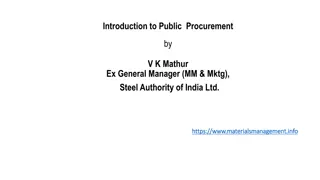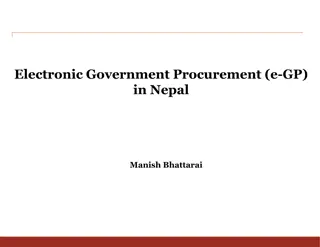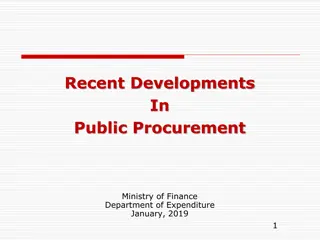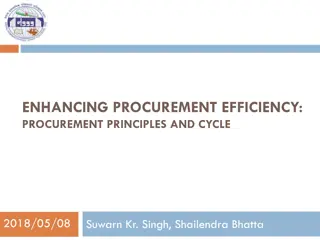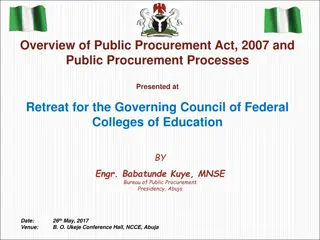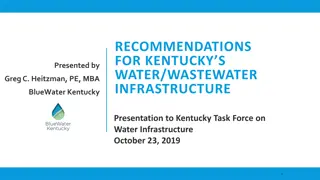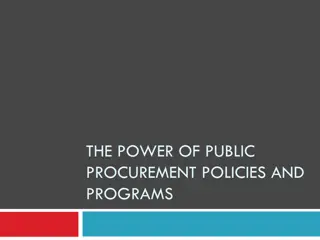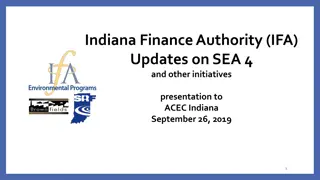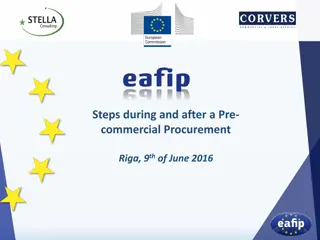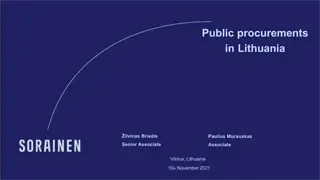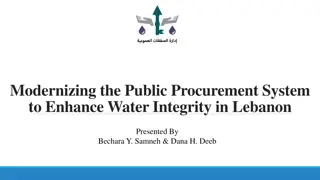Enhancing Procurement Efficiency in Water Infrastructure Development
Reflecting on experiences in supply chain management within the Department of Water and Sanitation to improve the effective utilization of resources, particularly focusing on timely supplier payments and addressing challenges leading to delays, inefficiencies, and increased expenditure. The department faces issues related to project delays, wasteful expenditure, and inefficiencies in centralized procurement processes that need to be addressed for better project delivery outcomes.
Download Presentation

Please find below an Image/Link to download the presentation.
The content on the website is provided AS IS for your information and personal use only. It may not be sold, licensed, or shared on other websites without obtaining consent from the author. Download presentation by click this link. If you encounter any issues during the download, it is possible that the publisher has removed the file from their server.
E N D
Presentation Transcript
PSC Roundtable: Efficient, Economic and Effective use of PRESENTATION TITLE Resources in the Procurement Environment Presented by: Name Surname Directorate Panel discussion Experiences in the Public Procurement Environment Date Trevor Balzer Acting Director-General Department of Water and Sanitation 28 October 2020
Purpose To reflect on the experiences related to Supply Chain Management in the Department of Water and Sanitation to advance the Efficient, Economic and effective use of resources with a focus on the timeous payment of suppliers. 2
Experiences in the SCM environment Section 217(1) of the Constitution provides that When an organ of state in the national, provincial or local sphere of government, or any other institution identified in national legislation, contracts for goods or services, it must do so in accordance with a system which is fair, equitable, transparent, competitive and cost-effective. Complying with the procurement prescripts contributes to efficient processes, possible good quality of service delivery including economic growth. The Department has incurred over the previous financial years irregular expenditure which was in contravention section 217 (1) of the constitution and National Treasury procurement prescripts. These contraventions has in many cases proved costly to the Department due to high litigation costs associated with these contracts also leading to losses, fruitless and wasteful expenditure. 3
Problem statement The Department has two accounts (Main and WTE) with a total budget for 2020/21 of R30.2 billion of which R17.9 billion is appropriated for infrastructure development. The Departmental Performance in delivering capital / infrastructure projects have been in a constant decline since 2015. This led to unacceptable delays in Water Resource Infrastructure and RBIG projects; and was even more prevalent where the Internal Construction Unit is the contractor. Delays also led to an increase in Fruitless and Wasteful expenditure. Inefficiencies which increase project costs. Developed a Culture of Inefficiency In 2017 the Supply Chain Policy centralised all procurement functions to be the responsibility of the Head of Supply Chain for both WTE and Main Account. (Procurement Process Bottleneck) 4
14. D: SCM (Acquisition) Bid Opening and Pre- Evaluation Administration (33 - 49+ days) 1. CD:CM Document Originator (5 days) 2. D: SCM Demand Management /Cross Functional Team (60+ days) 15. Bid Evaluation Committee Committee approved to evaluate the bids recieved (14+ days) 3. CD: ID/ CD: ES Support Document (4 days) 4. DDG: IBOM Recommendation (4 days) 16. CD:SCM Negotiations inconjunction with LS if applicable 21. Draftin g of contra ct by Line Functi on (3- 5 days) 22. Vettin g of contra ct by CD: LS (10+ days) 13. Tende r Closin g Tender date closing period (1 day) 24. Mobili sation to Site (1 day) 23. 12. 11. Signing of contract between DWS and Contracto r (1 day) 5. CD: SCM via SCM Central Point Demand Plan Check (14-30+ days) Breifing Session Pressentat ion to proposed bidders (1 day) Advertism ent Advertism ent of tender (21+ working days) 17. CD: SCM Prepare submission for appointment (30-90+days) Download Water drops PNG Image for Free 6. D: Management Accounting Recommend Budget Avaliabilty (2 days) 18. DBAC 7. CFO Bid Approval/ Recommendation for Appointment (7-21+ days) Fund Avaliblity Check (5+ days) 8. DBSC 19. CD: Risk Management if applicable above R20 million 432 working Days Specification Approval (27-59+ days) 9. DBAC Specification Approval/ Recommendation for Advertisment (7- 21 days) 20. Director General Bid Approval for Appointment for bids above R20 million (14 days) 10. Director General Specification Approval for Advertisment for bids above R20 million (14 days) Pre- Framework for Infrastructure Delivery and Procurement Management (FIDPM) Departmental procurement process duration 5
Framework for Infrastructure Delivery & Procurement Management The FIDPM process intended for procurement of infrastructure beyond R500k; and thus setting the performance target for National Bids. 1. Gate 1 (PG 1) 7 Days Obtain permission to start the procurement process 2. Gate 2 (PG 2) 7 Days Obtain approval for procurement strategies that are to be adopted 3. Gate 3 (PG 3) 14 Days Obtain approval for procurement docments Procurement below R500k will be quotation-based with a performance target of less than 1 calendar month. 4. Gate 4 (PG 4) 5 Days Confirm that cash flow is sufficient to meet projected contracual obilgations Duration for FIDPM Process Flow 5. Gater 5 (PG 5) 30 Days Solicit tender offers Download Water drops PNG Image for Free PG 8 1% PG 1 9% PG 7 9% 6. Gate 6 (PG 6) 7 Days PG 2 9% PG 6 9% Evaluate tender offers n terms of underakings and parameters established in procurement document 78 7. Gate 7 (PG 7) 7 Days working Days PG 3 18% Recommend the award Award the contract PG 5 39% PG 4 6% 8. Gate 8 (PG 8) 1 Day Administer the contract and confirm compliance with all contractual requirements 6
IPO proposal: objective Endeavour to deliver Infrastructure Projects within time and cost Performance Download Water drops PNG Image for Free Accountability Comply and Deliver Restore Procurement Confidence Transparency This in preparation of the establishment of the NWRI Agency, Keeping the Unit Management Accountable for Performance & Compliance 7
IPO proposal: functions Participating in project planning and project management meetings; Ensuring Compliance with SCM Regulations that All specifications are fit for submission into the procurement process. Placing tender advertisement in the Government Tender Bulletin; Loading bid documents on the e-portal; Administering the bid opening process; Administer the bid evaluation processes (monitoring and reporting performance); Prepare legal documentation for entering into contractual agreements with contractors and/or service providers; Establish bulk procurement options (according to line function demand) to allow for optimum pricing being in line with the (FIDPM) to lower costs and improve value for money; and Do market research on latest development of technical and engineering aspects to be captured on a database to assist line-function with specification development and design. Download Water drops PNG Image for Free 8
IPO proposal: governance The IPO will be regulated by ALL prescripts and regulations set by National Treasury and other relevant governing institutions (i.e. CIDB). Will operate within the confines of the Framework for Infrastructure Delivery and Procurement Management (FIDPM). The Chief Financial Officer will retain the oversight role over the functioning of the IPO but SCM delegations need to be amended in terms of Section 44 of the PFMA by the Accounting Officer. Risk Management will be essential with both establishment and operations of the IPO Internal Audit will include the IPO operations in its Audit Schedule to ensure consistent compliance improvement. Enhanced Transparency: Public (virtual) Opening of All National Bids Live Bid Tracking; to ensure integrity Two Envelop Bid Process 9
IPO Proposal Risk Management Key Risks Risk Mitigation The office of the CFO will have a compliance oversight role in this the functioning of the IPO; Risk Management will form part of the IPO Establishment Task Team National Treasury will also be consulted on the implementing strategy after approval is obtained to establish the IPO; The Transparent Performance-based Procurement Philosophy will be adopted and implemented with the primary objective of obtaining a record of clean governance. Employment of an Ethics Officer (with a Risk- Based Performance target set) i. There are risks to establishing a 2nd Supply Chain in WTE: Irregular Expenditure due to non-compliance with NT Regulations; Corruption; Intentional Interference for personal gain; ii. iii. Download Water drops PNG Image for Free iv. v. 10
IPO proposal: Initial proposed structure (a) IPO Manager (Pr. Eng/Tech) Office Manager (c)SCM Manager (SCM Professional ) (b)Engineering Manager (Pr. Eng/Tech) (d) Legal Officer (Legal Professionl) (f) Empowerment Compliance Officer (e) Ethics Officer SCM Assistants (X10) Engineering Staff (X4) Admin Support (x4) 11
IPO proposal: institutional arrangement Finance Personnel Apportioning Construction Projects to fund the IPO (20/21 budget: R22.5m)e Augmentation Fund can be used to augment. a 0.5% of all Section 76 (NWA) Appointments 3 Year performance-based contracts (with renewals/extensions based upon achieving targets) Organisational Placement Report into the NWRI Branch Oversight from CFO Preparation for the Establishment of the NWR Agency (proto-operations) 12
IPO Proposal Way Forward Upon Approval by Accounting Officer the following is to be done: i. Engage National Treasury to obtain support and to clarify inconsistencies. ii. Review DWS Supply Chain Policy to incorporate IPO iii. Draft IPO Business Protocol to define Governance and Compliance iv. Set IPO Performance KPI s and draft Contracts accordingly v. To set a target of a fully operational IPO within 2 months of approval. Download Water drops PNG Image for Free 13
Challenges experienced in the payment of suppliers The Department s normal invoices are being processed within the prescribed 30 days period. The effects of incidents of unauthorised, irregular, fruitless and wasteful expenditure normally manifests through the payment systems. Such payments remain unpaid for extended period of time, with some involving legal proceedings. Synopsis of unpaid invoices and impact on emerging entrepreneurs. 14
30 days turnaround strategy (being implemented) Standard Operating Procedures for Invoice Management (A circular Issued) Centralisation of invoice management Electronic invoice tracking system is on the pilot phase for implementation Stakeholder engagements (Dedicated efforts to proactively engage suppliers on verifications, reconciliations, banking details, etc) Cash management interventions enhancement strategies to make funds available and Revenue collection
Turnaround Strategy including consequence management Turnaround Strategy The Department developed a Turnaround Strategy, this strategy is an enterprise- wide strategy encompassing both business (Policy and Programmes) and financial elements. Financial management, supply chain management, investigations into maladministration, policies, systems, business processes and standard operation processes that contributes to the functioning of identified areas or components. The strategy has been institutionalised by including in the Annual Performance Plan of the Department. The implementation and monitoring activities are also embedded in the Branch s performance management. Consequence management One of the pillars of the Department s Turnaround strategy is the implementation of consequence management, which Parliament required when approving the Department s budget in the 2019/20 financial year. This involves Departmental disciplinary inquiries, investigations by SAPS, SIU and condonation processes with National Treasury. 16
Thank you 17
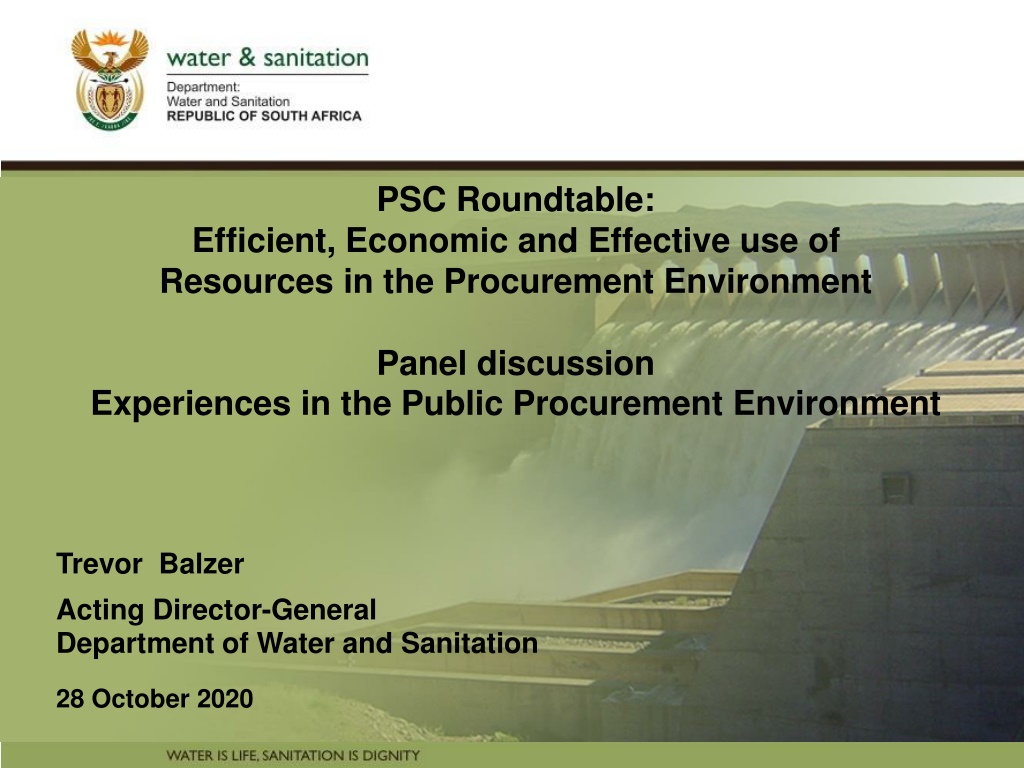




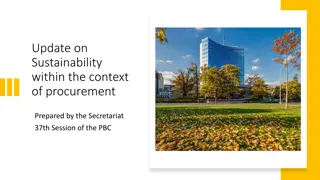
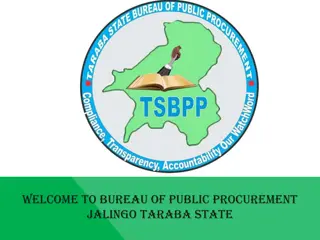

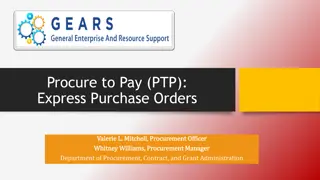
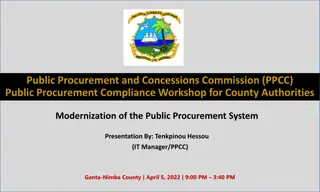

![Comprehensive Overview of Corruption Watch Submission on Public Procurement Bill [B18B-2023]](/thumb/138344/comprehensive-overview-of-corruption-watch-submission-on-public-procurement-bill-b18b-2023.jpg)
